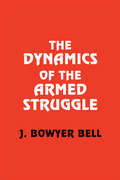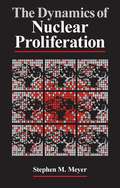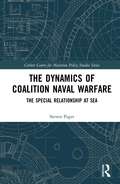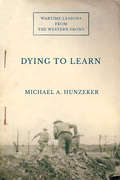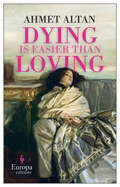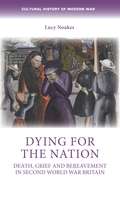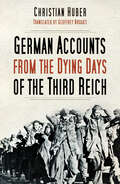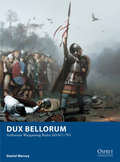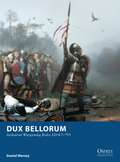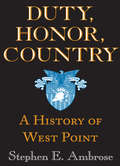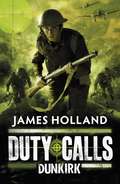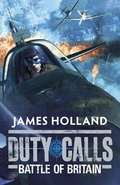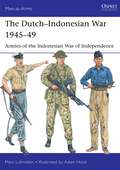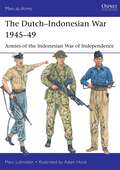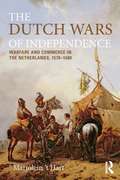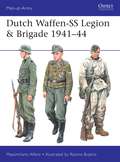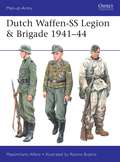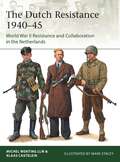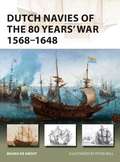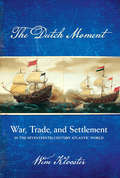- Table View
- List View
The Dynamics of the Armed Struggle
by J. Bowyer BellThis is an analysis of one of the most prevalent forms of political violence at the end of the millennium. The author has been shot at, kidnapped, expelled and questioned in wars from Central America to Northern Ireland. The book reflects his access to the cultures of political violence.
The Dynamics of Nuclear Proliferation
by Stephen M. MeyerStephen M. Meyer steps back from the emotions and rhetoric surrounding the nuclear arms debates to provide a systematic examination of the underlying determinants of nuclear weapons proliferation. Looking at current theories of nuclear proliferation, he asks: Must a nation that acquires the technical capability to manufacture nuclear weapons eventually do so? In an analysis, remarkable for its rigor and accessibility, Meyer provides the first empirical, statistical model explaining why particular countries became nuclear powers when they did. His findings clearly contradict the notion that the pace of nuclear proliferation is controlled by a technological imperative and show that political and military factors account for the past decisions of nations to acquire or forgo the development of nuclear weapons.
The Dynamics of Coalition Naval Warfare: The Special Relationship at Sea (Corbett Centre for Maritime Policy Studies Series)
by Steven PagetThis book examines the dynamics of coalition naval operations. Since the end of the Second World War, few nations possess the capacity for large scale, sustained and independent naval operations; and even those that do, such as the USA, often find it economically, militarily and politically expedient to act multilaterally. As such, coalition naval operations increasingly became the norm throughout the twentieth-century, and there is little sign of this abating in the twenty-first. Multinational operations provide a number of benefits, but they also present a number of challenges. Examining the dynamics of coalition operations involving the Royal Navy (RN), Royal Australian Navy (RAN) and the United States Navy (USN) during the Korean War, Vietnam War and the Iraq War, this book provides a broad overview of naval interoperability between the three navies. Using the naval gunfire support (NGS) capability as a lens through which to analyse operations, the study explores a diverse range of issues, including: command and control, communications, equipment standardisation, intelligence, logistics, planning, rules of engagement, tactics, techniques and procedures and training. Approaching the subject through both historical and contemporary perspectives not only provides a unique assessment of the variation in the effectiveness of interoperability over time, but also offers a platform for better understanding and enhancing the performance of future coalition naval operations. Based on extensive archival research in Australia, the UK and the US, as well as wide-ranging interviews, this book sheds new light on the dynamics of conducting coalition operations. This book will be of great interest to students of naval history, strategic studies, sea power, maritime security, military studies, and IR in general.
The Dynamics of Coalition Naval Warfare: The Special Relationship at Sea (Corbett Centre for Maritime Policy Studies Series)
by Steven PagetThis book examines the dynamics of coalition naval operations. Since the end of the Second World War, few nations possess the capacity for large scale, sustained and independent naval operations; and even those that do, such as the USA, often find it economically, militarily and politically expedient to act multilaterally. As such, coalition naval operations increasingly became the norm throughout the twentieth-century, and there is little sign of this abating in the twenty-first. Multinational operations provide a number of benefits, but they also present a number of challenges. Examining the dynamics of coalition operations involving the Royal Navy (RN), Royal Australian Navy (RAN) and the United States Navy (USN) during the Korean War, Vietnam War and the Iraq War, this book provides a broad overview of naval interoperability between the three navies. Using the naval gunfire support (NGS) capability as a lens through which to analyse operations, the study explores a diverse range of issues, including: command and control, communications, equipment standardisation, intelligence, logistics, planning, rules of engagement, tactics, techniques and procedures and training. Approaching the subject through both historical and contemporary perspectives not only provides a unique assessment of the variation in the effectiveness of interoperability over time, but also offers a platform for better understanding and enhancing the performance of future coalition naval operations. Based on extensive archival research in Australia, the UK and the US, as well as wide-ranging interviews, this book sheds new light on the dynamics of conducting coalition operations. This book will be of great interest to students of naval history, strategic studies, sea power, maritime security, military studies, and IR in general.
Dying to Learn: Wartime Lessons from the Western Front (Cornell Studies in Security Affairs)
by Michael A. HunzekerIn Dying to Learn, Michael Hunzeker develops a novel theory to explain how wartime militaries learn. He focuses on the Western Front, which witnessed three great-power armies struggle to cope with deadlock throughout the First World War, as the British, French, and German armies all pursued the same solutions-assault tactics, combined arms, and elastic defense in depth. By the end of the war, only the German army managed to develop and implement a set of revolutionary offensive, defensive, and combined arms doctrines that in hindsight represented the best way to fight.Hunzeker identifies three organizational variables that determine how fighting militaries generate new ideas, distinguish good ones from bad ones, and implement the best of them across the entire organization. These factors are: the degree to which leadership delegates authority on the battlefield; how effectively the organization retains control over soldier and officer training; and whether or not the military possesses an independent doctrinal assessment mechanism.Through careful study of the British, French, and German experiences in the First World War, Dying to Learn provides a model that shows how a resolute focus on analysis, command, and training can help prepare modern militaries for adapting amidst high-intensity warfare in an age of revolutionary technological change.
Dying is Easier than Loving (The Ottoman Quartet #3)
by Ahmet Altan“A deeply compelling and immersive narrative about love, desire, loneliness and landscape.”—Elif Shafak (on book 1 of the series) “Altan uses a Tolstoyan combination of the epic and the intimate to explore questions of national identity and historical narrative.”—The Observer “Altan’s descriptions of a stifling atmosphere of authoritarian repression in Istanbul in the early 1900s conjure up constant comparisons with today’s Turkey.”—The TLS The third book in the Ottoman Quartet, set in the years leading up to WWI, is steeped in the tumultuous events and the political struggle that shaped 20th century Turkey, from the war against the Bulgarian army and the coup that resulted in the nation’s one-party rule. Against this background, a tormented, obsessive love affair unfolds between Nizam, the son of Hikmet Bey, and Russian pianist Anya. This tapestry of love and war allows Altan to analyse the structure of male power and its degeneration into violence against women, uncompromising nationalism, and pervasive censorship. Atan confirms himself as a caustic, courageous writer, never afraid to denounce an arrogant and undemocratic power, allowing the reader to read between the lines the situation of contemporary Turkey.
Dying for the nation: Death, grief and bereavement in Second World War Britain (Cultural History of Modern War)
by Lucy NoakesDeath in war matters. It matters to the individual, threatened with their own death, or the death of loved ones. It matters to groups and communities who have to find ways to manage death, to support the bereaved and to dispose of bodies amidst the confusion of conflict. It matters to the state, which has to find ways of coping with mass death that convey a sense of gratitude and respect for the sacrifice of both the victims of war, and those that mourn in their wake. This social and cultural history of Britain in the Second World War places death at the heart of our understanding of the British experience of conflict. Drawing on a range of material, Dying for the nation demonstrates just how much death matters in wartime and examines the experience, management and memory of death. The book will appeal to anyone with an interest in the social and cultural history of Britain in the Second World War.
Dying for the nation: Death, grief and bereavement in Second World War Britain (Cultural History of Modern War)
by Lucy NoakesDeath in war matters. It matters to the individual, threatened with their own death, or the death of loved ones. It matters to groups and communities who have to find ways to manage death, to support the bereaved and to dispose of bodies amidst the confusion of conflict. It matters to the state, which has to find ways of coping with mass death that convey a sense of gratitude and respect for the sacrifice of both the victims of war, and those that mourn in their wake. This social and cultural history of Britain in the Second World War places death at the heart of our understanding of the British experience of conflict. Drawing on a range of material, Dying for the nation demonstrates just how much death matters in wartime and examines the experience, management and memory of death. The book will appeal to anyone with an interest in the social and cultural history of Britain in the Second World War.
The Dying Days of the Third Reich: German Accounts from World War II
by Christian HuberIt has taken seventy years for the accounts of ordinary German soldiers during the Second World War to be made widely available to an English-speaking audience. This is hardly surprising given that interest in these important documents has only recently surfaced in Germany, where a long process of coming to terms with the past, or Vergangenheitsbewältigung, has taken place. Unlike other historical depictions of the fall of the Third Reich, Dying Days of the Third Reich presents the authentic voices of those German soldiers who fought on the front line. Throughout we are witness to the kind of bravery, ingenuity and, ultimately, fear that we are so familiar with from the many Allied accounts of this time. Their sense of confusion and terror is palpable as Nazi Germany finally collapses in May 1945, with soldiers fleeing to the American victors instead of the Russians in the hope of obtaining better treatments as a prisoner of war. This collection of first-hand accounts includes the stories of German soldiers fighting the Red Army on the Eastern Front; of Horst Messer, who served on the last East Prussian panzer tank but was captured and spent four years in Russian captivity at Riga; Hans Obermeier, who recounts his capture on the Czech front and escape from Siberia; and a moving account of an anonymous Wehrmacht soldier in Slovakia given orders to execute Russian prisoners.
Dux Bellorum: Arthurian Wargaming Rules AD367–793 (Osprey Wargames #1)
by Daniel Mersey José Daniel PeñaThe Dark Age of Britain, from the middle of the 4th century to the end of the 8th, was a time of violence and warfare, when charismatic warlords such as the fabled King Arthur could gather together armies and carve out their own kingdoms. With this new set of wargames rules, players can take on the role of these warlords and command their own armies on the tabletop. Written by the author of the popular Glutter of Ravens rules set, Dux Bellorum is an element-based system, where each base of figures represents 50 fighting men. Each player has a specific number of points with which to construct his force and can choose a Late Roman, Romano-British, Welsh, Saxon, Pictish, Irish, or Sea Raider army, amongst others. The game is then played out following a set of simple, fast-paced rules. A completely self-contained gaming system, Dux Bellorum is perfect for gamers who are looking for a way into fighting Dark Age battles without investing a lot of time or money in larger rulesets.
Dux Bellorum: Arthurian Wargaming Rules AD367–793 (Osprey Wargames)
by Daniel Mersey José Daniel PeñaThe Dark Age of Britain, from the middle of the 4th century to the end of the 8th, was a time of violence and warfare, when charismatic warlords such as the fabled King Arthur could gather together armies and carve out their own kingdoms. With this new set of wargames rules, players can take on the role of these warlords and command their own armies on the tabletop. Written by the author of the popular Glutter of Ravens rules set, Dux Bellorum is an element-based system, where each base of figures represents 50 fighting men. Each player has a specific number of points with which to construct his force and can choose a Late Roman, Romano-British, Welsh, Saxon, Pictish, Irish, or Sea Raider army, amongst others. The game is then played out following a set of simple, fast-paced rules. A completely self-contained gaming system, Dux Bellorum is perfect for gamers who are looking for a way into fighting Dark Age battles without investing a lot of time or money in larger rulesets.
Duty, Honor, Country: A History of West Point
by Stephen E. AmbroseThis new paperback edition of Stephen E. Ambrose's highly regarded history of the United States Military Academy features the original foreword by Dwight D. Eisenhower and a new afterword by former West Point superintendent Andrew J. Goodpaster.
Duty Calls: Dunkirk (Duty Calls)
by James Holland'YOU WANTED TO SEE SOME ACTION - WELL YOU'RE GOING TO GET IT NOW. YOU'RE GOING TO GET IT NOW ALL RIGHT.'Friday 24th May, 1940Private Johnny Hawke, aged sixteen, awakens to artillery fire.Hours later, Stukas scream down from the sky. Messerschmit fighters roar towards his regiment. Trucks burst into flames.Now men and mules lay dead and dying, severed limbs twisted grotesquely as blood soaks the cobbled streets.Young Private Hawke just wants to do his duty and serve his country. But as he - and his fellow soldiers - prepare to stop the German advance, there's only one question on everyone's lips.HOW WILL THEY SURVIVE?
Duty Calls: World War 2 Fiction (Duty Calls)
by James HollandPilot officer Archie Jackson, 19, is in control of the RAF's newest fighter aircraft, a Supermarine Spitfire.Now he has the Luftwaffe in his sights and only one thing matters: defending Britain. Suddenly planes are falling from the sky, exploding and spiralling into the English Channel.France has fallen and the swastika flies over Occupied Europe. Only these young pilots - barely out of boyhood - stand between Britain and a Nazi invasion . . . Duty Calls: Battle of Britain, throws you deep into the heart - and horror - of Britain's darkest, and finest, hour.** Historian James Holland is the bestselling author of the Jack Tanner adult war fiction books. Duty Calls is his first series for younger readers, and showcases his expertise on the Second World War. ** James Holland presented Battle of Britain: The Real Story on BBC2.
The Dutch–Indonesian War 1945–49: Armies of the Indonesian War of Independence (Men-at-Arms)
by Marc LohnsteinHighly detailed and colourful, this account illustrates the struggle of Indonesian forces in their War of Independence against the Netherlands, following the surrender of occupying Japanese forces in 1945.Following on from MAA 521 Royal Netherlands East Indies Army 1936–42 and completing the coverage of the post-World War II wars of decolonization, The Dutch–Indonesian War 1945–49 describes the Japanese surrender in September 1945 which left a power vacuum in the colonial Dutch East Indies (Indonesia). Using vivid colour illustrations and rare photos, this title depicts the various forces involved in the struggle for Indonesia: the British Indian Army troops sent to key areas to disarm Japanese garrisons, the Indonesian nationalists who immediately proclaimed an independent Republic, remaining Japanese troops, and the Dutch forces which arrived in 1946.The wide dispersion of populations, and their ethnic, religious and political differences ensured that the struggle which followed was complex. Fragmented bands of nationalist permuda insurgents were slowly brought together under command of a republican army (the BKR, later TKR, and finally the TNI, complete with naval and air elements), but stubborn negotiations alternated with bouts of major fighting. This book details how the nationalists were defeated by Dutch and Dutch-led local forces in urban areas (e.g. during Operations Product and Crow, 1947 and 1948), but how their guerrillas evaded Dutch troops in the jungle hills and swamps. Illustrating a wide range of uniforms, insignia, personal weapons and equipment, this study showcases the troops and armour involved in the conflict.
The Dutch–Indonesian War 1945–49: Armies of the Indonesian War of Independence (Men-at-Arms)
by Marc LohnsteinHighly detailed and colourful, this account illustrates the struggle of Indonesian forces in their War of Independence against the Netherlands, following the surrender of occupying Japanese forces in 1945.Following on from MAA 521 Royal Netherlands East Indies Army 1936–42 and completing the coverage of the post-World War II wars of decolonization, The Dutch–Indonesian War 1945–49 describes the Japanese surrender in September 1945 which left a power vacuum in the colonial Dutch East Indies (Indonesia). Using vivid colour illustrations and rare photos, this title depicts the various forces involved in the struggle for Indonesia: the British Indian Army troops sent to key areas to disarm Japanese garrisons, the Indonesian nationalists who immediately proclaimed an independent Republic, remaining Japanese troops, and the Dutch forces which arrived in 1946.The wide dispersion of populations, and their ethnic, religious and political differences ensured that the struggle which followed was complex. Fragmented bands of nationalist permuda insurgents were slowly brought together under command of a republican army (the BKR, later TKR, and finally the TNI, complete with naval and air elements), but stubborn negotiations alternated with bouts of major fighting. This book details how the nationalists were defeated by Dutch and Dutch-led local forces in urban areas (e.g. during Operations Product and Crow, 1947 and 1948), but how their guerrillas evaded Dutch troops in the jungle hills and swamps. Illustrating a wide range of uniforms, insignia, personal weapons and equipment, this study showcases the troops and armour involved in the conflict.
The Dutch Wars of Independence: Warfare and Commerce in the Netherlands 1570-1680 (Modern Wars In Perspective)
by Marjolein 't HartIn The Dutch Wars of Independence, Marjolein ’t Hart assesses the success of the Dutch in establishing their independence through their eighty years struggle with Spain - one of the most remarkable achievements of the sixteenth and seventeenth centuries. Other rebellions troubled mighty powers of this epoch, but none resulted in the establishment of an independent, republican state. This book: tells the story of the Eighty Years War and its aftermath, including the three Anglo-Dutch Wars and the Guerre de Hollande (1570-1680). explores the interrelation between war, economy and society, explaining how the Dutch could turn their wars into commercial successes. illustrates how war could trigger and sustain innovations in the field of economy and state formation ; the new ways of organization of Dutch military institutions favoured a high degree of commercialized warfare. shows how other state rulers tried to copy the Dutch way of commercialized warfare, in particular in taking up the protection for capital accumulation. As such, the book unravels one of the unknown pillars of European state formation (and of capitalism). The volume investigates thoroughly the economic profitability of warfare in the early modern period and shows how smaller, commercialized states could sustain prolonged war violence common to that period. It moves beyond traditional explanations of Dutch success in warfare focusing on geography, religion, diplomacy while presenting an up-to-date overview and interpretation of the Dutch Revolt, the Anglo-Dutch Wars and the Guerre de Hollande.
The Dutch Wars of Independence: Warfare and Commerce in the Netherlands 1570-1680 (Modern Wars In Perspective)
by Marjolein 't HartIn The Dutch Wars of Independence, Marjolein ’t Hart assesses the success of the Dutch in establishing their independence through their eighty years struggle with Spain - one of the most remarkable achievements of the sixteenth and seventeenth centuries. Other rebellions troubled mighty powers of this epoch, but none resulted in the establishment of an independent, republican state. This book: tells the story of the Eighty Years War and its aftermath, including the three Anglo-Dutch Wars and the Guerre de Hollande (1570-1680). explores the interrelation between war, economy and society, explaining how the Dutch could turn their wars into commercial successes. illustrates how war could trigger and sustain innovations in the field of economy and state formation ; the new ways of organization of Dutch military institutions favoured a high degree of commercialized warfare. shows how other state rulers tried to copy the Dutch way of commercialized warfare, in particular in taking up the protection for capital accumulation. As such, the book unravels one of the unknown pillars of European state formation (and of capitalism). The volume investigates thoroughly the economic profitability of warfare in the early modern period and shows how smaller, commercialized states could sustain prolonged war violence common to that period. It moves beyond traditional explanations of Dutch success in warfare focusing on geography, religion, diplomacy while presenting an up-to-date overview and interpretation of the Dutch Revolt, the Anglo-Dutch Wars and the Guerre de Hollande.
Dutch Waffen-SS Legion & Brigade 1941–44 (Men-at-Arms)
by Massimiliano AfieroGoebbels' 1941 propaganda campaign to present Germany's invasion of the USSR as a battle for European civilization against Asian barbarism convinced many men in occupied 'Germanic' European countries, such as Scandinavia and the Low Countries, to volunteer to fight on the Russian Front. One of the strongest national legions of such a kind was raised in the Netherlands, where it was supported by a large pro-Nazi movement led by Anton Mussert. The 3,000-man Netherlands Volunteer Legion fought on the Leningrad front in regimental strength, from the Red Army's winter 1941/42 counter-offensive until April 1943. The survivors were then reinforced to form a 5,500-strong Panzergrenadier Brigade, and after anti-partisan service in Croatia, they returned to Army Group North as part of Steiner's III SS Panzer Korps, fighting in the most arduous battles of 1943–44 until driven back into Pomerania. In the final months of the war the division formed the nucleus of the new 23rd SS Volunteer Panzergrenadier Division 'Nederland'.In this illustrated study of the Dutch Waffen-SS Legion and Brigade, specialist Massimiliano Afiero explores the full history of this important formation from its establishment in 1941 until it was incorporated into the 'Nederland' Division in 1944. Contemporary photographs and full-colour illustrations support the text and reveal key details including aspects of uniform and insignia.
Dutch Waffen-SS Legion & Brigade 1941–44 (Men-at-Arms)
by Massimiliano AfieroGoebbels' 1941 propaganda campaign to present Germany's invasion of the USSR as a battle for European civilization against Asian barbarism convinced many men in occupied 'Germanic' European countries, such as Scandinavia and the Low Countries, to volunteer to fight on the Russian Front. One of the strongest national legions of such a kind was raised in the Netherlands, where it was supported by a large pro-Nazi movement led by Anton Mussert. The 3,000-man Netherlands Volunteer Legion fought on the Leningrad front in regimental strength, from the Red Army's winter 1941/42 counter-offensive until April 1943. The survivors were then reinforced to form a 5,500-strong Panzergrenadier Brigade, and after anti-partisan service in Croatia, they returned to Army Group North as part of Steiner's III SS Panzer Korps, fighting in the most arduous battles of 1943–44 until driven back into Pomerania. In the final months of the war the division formed the nucleus of the new 23rd SS Volunteer Panzergrenadier Division 'Nederland'.In this illustrated study of the Dutch Waffen-SS Legion and Brigade, specialist Massimiliano Afiero explores the full history of this important formation from its establishment in 1941 until it was incorporated into the 'Nederland' Division in 1944. Contemporary photographs and full-colour illustrations support the text and reveal key details including aspects of uniform and insignia.
The Dutch Resistance 1940–45: World War II Resistance and Collaboration in the Netherlands (Elite)
by Klaas Castelein Michel WentingDescribes and illustrates the full range of Dutch resistance groups and German and collaborationist counter-resistance groups during the Nazi occupation in 1940-45.The Nazi occupation of the Netherlands in World War II followed a complex course, whose scope is not widely understood. It was a great deal broader and more varied than the much-reported German counter-espionage success against Dutch agents parachuted in by the Special Operations Executive. From spring 1943 onwards, three Dutch Resistance organizations gained momentum: the Order Service (OD), the Resistance Council (RVV), and the National Assault Teams (LKP). In response, the Germans raised collaborationist forces to counter the Resistance, including the much-feared Landwacht. In September 1944 the OD, RVV and LKP amalgamated into the Netherlands Interior Forces (NBS), while Allied troops began to liberate the southern provinces. This allowed NBS forces in the south to form Stoottroepen, uniformed and armed by both the British and US armies. These assisted the Allied advance, while a bloody underground struggle continued in the occupied north until final liberation in April–May 1945. Illustrated with rare photos and new colour plates, this book gives a comprehensive account of one of the lesser-known struggles of World War II.
The Dutch Resistance 1940–45: World War II Resistance and Collaboration in the Netherlands (Elite)
by Klaas Castelein Michel WentingDescribes and illustrates the full range of Dutch resistance groups and German and collaborationist counter-resistance groups during the Nazi occupation in 1940-45.The Nazi occupation of the Netherlands in World War II followed a complex course, whose scope is not widely understood. It was a great deal broader and more varied than the much-reported German counter-espionage success against Dutch agents parachuted in by the Special Operations Executive. From spring 1943 onwards, three Dutch Resistance organizations gained momentum: the Order Service (OD), the Resistance Council (RVV), and the National Assault Teams (LKP). In response, the Germans raised collaborationist forces to counter the Resistance, including the much-feared Landwacht. In September 1944 the OD, RVV and LKP amalgamated into the Netherlands Interior Forces (NBS), while Allied troops began to liberate the southern provinces. This allowed NBS forces in the south to form Stoottroepen, uniformed and armed by both the British and US armies. These assisted the Allied advance, while a bloody underground struggle continued in the occupied north until final liberation in April–May 1945. Illustrated with rare photos and new colour plates, this book gives a comprehensive account of one of the lesser-known struggles of World War II.
Dutch Navies of the 80 Years' War 1568–1648 (New Vanguard)
by Peter Bull Bouko De GrootThe tiny new state of the United Provinces of the Netherlands won its independence from the mighty Spanish empire by fighting and winning the Eighty Years' War, from 1568 and 1648. In this long conflict, warfare on water played a much bigger role in determining the ultimate victor. On the high seas the fleet carved out a new empire, growing national income to such levels that it could continue the costly war for independence. Yet it was in coastal and inland waters that the most decisive battles were fought. Arguably the most decisive Spanish siege (Leiden, 1574) was broken by a fleet sailing to the rescue across flooded polders, and the battle of Nieuwpoort in 1600, the largest successful invasion fleet before World War II, was one of the most decisive battle in western history. Using detailed full colour artwork, this book shows how the Dutch navies fought worldwide in their war of independence, from Brazil to Indonesia, and from the Low Countries to Angola.
Dutch Navies of the 80 Years' War 1568–1648 (New Vanguard)
by Peter Bull Bouko De GrootThe tiny new state of the United Provinces of the Netherlands won its independence from the mighty Spanish empire by fighting and winning the Eighty Years' War, from 1568 and 1648. In this long conflict, warfare on water played a much bigger role in determining the ultimate victor. On the high seas the fleet carved out a new empire, growing national income to such levels that it could continue the costly war for independence. Yet it was in coastal and inland waters that the most decisive battles were fought. Arguably the most decisive Spanish siege (Leiden, 1574) was broken by a fleet sailing to the rescue across flooded polders, and the battle of Nieuwpoort in 1600, the largest successful invasion fleet before World War II, was one of the most decisive battle in western history. Using detailed full colour artwork, this book shows how the Dutch navies fought worldwide in their war of independence, from Brazil to Indonesia, and from the Low Countries to Angola.
The Dutch Moment: War, Trade, and Settlement in the Seventeenth-Century Atlantic World
by Wim KloosterIn The Dutch Moment, Wim Klooster shows how the Dutch built and eventually lost an Atlantic empire that stretched from the homeland in the United Provinces to the Hudson River and from Brazil and the Caribbean to the African Gold Coast. The fleets and armies that fought for the Dutch in the decades-long war against Spain included numerous foreigners, largely drawn from countries in northwestern Europe. Likewise, many settlers of Dutch colonies were born in other parts of Europe or the New World. The Dutch would not have been able to achieve military victories without the native alliances they carefully cultivated. Indeed, the Dutch Atlantic was quintessentially interimperial, multinational, and multiracial. At the same time, it was an empire entirely designed to benefit the United Provinces. The pivotal colony in the Dutch Atlantic was Brazil, half of which was conquered by the Dutch West India Company. Its brief lifespan notwithstanding, Dutch Brazil (1630–1654) had a lasting impact on the Atlantic world. The scope of Dutch warfare in Brazil is hard to overestimate—this was the largest interimperial conflict of the seventeenth-century Atlantic. Brazil launched the Dutch into the transatlantic slave trade, a business they soon dominated. At the same time, Dutch Brazil paved the way for a Jewish life in freedom in the Americas after the first American synagogues opened their doors in Recife. In the end, the entire colony eventually reverted to Portuguese rule, in part because Dutch soldiers, plagued by perennial poverty, famine, and misery, refused to take up arms. As they did elsewhere, the Dutch lost a crucial colony because of the empire’s systematic neglect of the very soldiers on whom its defenses rested.After the loss of Brazil and, ten years later, New Netherland, the Dutch scaled back their political ambitions in the Atlantic world. Their American colonies barely survived wars with England and France. As the imperial dimension waned, the interimperial dimension gained strength. Dutch commerce with residents of foreign empires thrived in a process of constant adaptation to foreign settlers’ needs and mercantilist obstacles.
